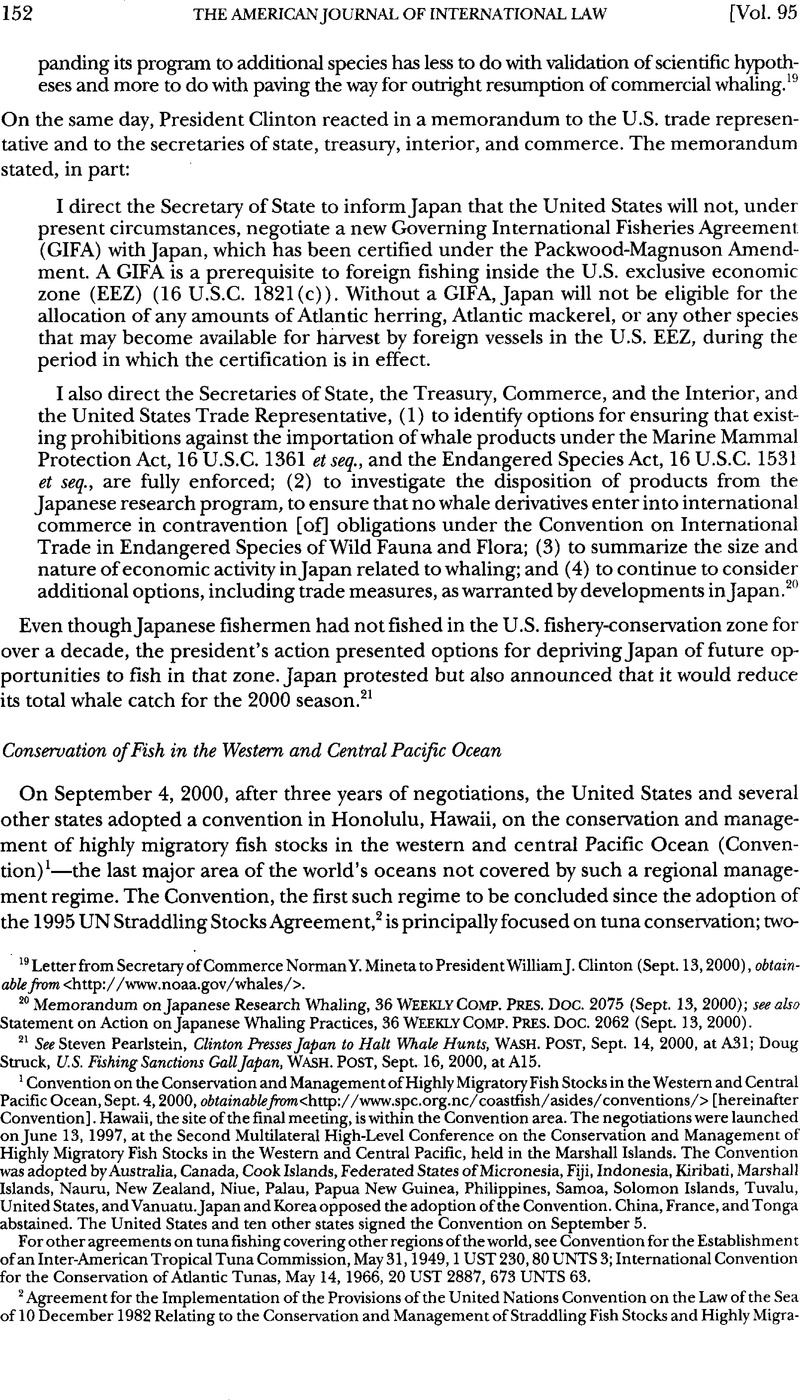No CrossRef data available.
Article contents
Conservation of Fish in the Western and Central Pacific Ocean
Published online by Cambridge University Press: 30 March 2017
Abstract

- Type
- Contemporary Practice of the United States Relating to International Law
- Information
- Copyright
- Copyright © American Society of International Law 2001
References
1 Convention on the Conservation and Management of Highly Migratory Fish Stocks in the Western and Central Pacific Ocean, Sept. 4,2000, obtainable from <http://www.spc.org.nc/coastfish/asides/conventions/> [hereinafter Convention]. Hawaii, the site of the final meeting, is within the Convention area. The negotiations were launched on June 13, 1997, at the Second Multilateral High-Level Conference on the Conservation and Management of Highly Migratory Fish Stocks in the Western and Central Pacific, held in the Marshall Islands. The Convention was adopted by Australia, Canada, Cook Islands, Federated States of Micronesia, Fiji, Indonesia, Kiribati, Marshall Islands, Nauru, New Zealand, Niue, Palau, Papua New Guinea, Philippines, Samoa, Solomon Islands, Tuvalu, United States, and Vanuatu. Japan and Korea opposed the adoption of the Convention. China, France, and Tonga abstained. The United States and ten other states signed the Convention on September 5.
For other agreements on tuna fishing covering other regions of the world, see Convention for the Establishment of an Inter-American Tropical Tuna Commission, May31,1949,1 UST 230,80 UNTS 3; International Convention for the Conservation of Atlantic Tunas, May 14, 1966, 20 UST 2887, 673 UNTS 63.
2 Agreement for the Implementation of the Provisions of the United Nations Convention on the Law of the Sea of 10 December 1982 Relating to the Conservation and Management of Straddling Fish Stocks and Highly Migratory Fish Stocks, Aug. 4, 1995, UN Law of The Sea Bull., NO. 29, at 25 (1995), reprinted in 34 ILM 1542 (1995) [hereinafter Straddling Stocks Agreement]. The agreement sets forth principles on: compliance and enforcement; fishing by nonmembers of a regional fisheries-management organization; new entrants into a fishery; dispute settlement; precautionary management; and transparency in decision making. The United States has ratified the agreement, which has not yet entered into force.
3 See Countries Vote to Create Tuna Regulation Commission, Wash. Post, Sept. 6, 2000, at A20. The Convention also covers other highly migratory stocks of importance in this region, such as martin, swordfish, and sailfish.
4 Convention, supra note 1, Art. 10(a), (b), (i).
5 Id., Art. 3.
6 Id., Art. 7(1).
7 Id., Art. 8(3).
8 Id., Art. 10(3).
9 Id., Art. 6(2).
10 Id., Art. 9(2), Annex 1. Paragraph 2 of the annex reserves certain political functions under the Convention to contracting parties (for example, the right to admit new states and the selection of the headquarters of the commission).
11 Id., Art. 10(4).
12 Id., Art. 20(1 )–(2). The three-fourths majority must be achieved with respect to members of the South Pacific Forum Fisheries Agency and separately with respect to nonmembers, thus creating a two-”chamber” commission. Further, proposals on matters of substance cannot be defeated by two or fewer votes in either chamber, thereby preventing a very small minority from wielding a veto power. Id., Art. 20(2).
13 Id., Art. 20(6), Annex II.
14 Id., Art. 25.
15 Id., Art. 26.
16 Id., Art. 28.
17 Id., Art. 25(12).
18 Straddling Stocks Agreement, supra note 2, pt. VIII.
19 U.S. Dep’t of State Press Release on Successful Conclusion of Western Pacific Fisheries Negotiations (Sept. 6, 2000), obtainable from <http://www.state.gov>.




